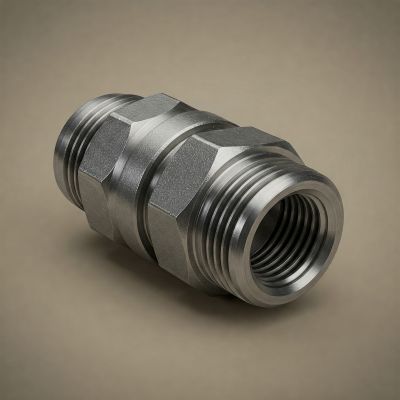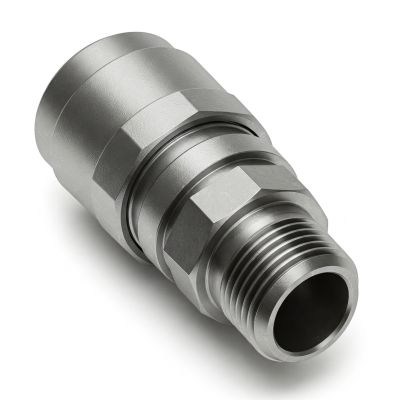Flaring is a crucial process in automotive and hydraulic systems, ensuring secure and leak-free connections for fluid transfer. Whether you’re working on brake lines, fuel lines, or hydraulic systems, selecting the correct flare type is essential for both performance and safety.
Two of the most commonly used flare types are inverted flare and bubble flare. Each has its own unique design, applications, and advantages. This guide will provide a comprehensive comparison to help you understand their differences and determine which one best suits your needs.
What Are Flare Fittings?
Flare fittings are a type of compression fitting designed to create a tight seal in high-pressure fluid systems. The tubing end is flared outward using a flaring tool, allowing it to fit securely into a corresponding flare nut or fitting.
Proper sealing is essential in preventing leaks, especially in brake and fuel lines where high-pressure fluid movement is constant. Incorrect flare selection or installation can result in leaks, system failure, and safety hazards.
What Is an Inverted Flare?
An inverted flare, also known as a double flare, is created by folding the tube end inward and then flaring it outward. This double-layered structure enhances strength and durability, making it suitable for high-pressure applications.
Common Applications
➡️ Brake lines (common in North American vehicles)
➡️ Fuel lines
➡️ Hydraulic systems
Advantages and Disadvantages
Advantages:
➡️ Strong and durable due to the double-layer structure
➡️ Resistant to cracking under high pressure
➡️ Common in automotive applications, making replacement parts readily available
Disadvantages:
➡️ Requires more effort and precision to create
➡️ Specialized tools needed for proper flaring
What Is a Bubble Flare?
A bubble flare (also called an ISO flare) is a single flare that forms a “bubble” shape at the tubing end. It is commonly used in modern and European braking systems.
Common Applications
➡️ Brake lines in European and modern vehicles
➡️ Some fuel systems
➡️ Hydraulic systems
Advantages and Disadvantages
Advantages:
➡️ Easier to create than an inverted flare
➡️ Widely used in European vehicles
➡️ Works well with metric fittings
Disadvantages:
➡️ Less durable than an inverted flare due to its single-layer design
➡️ More prone to cracking under extreme pressure
➡️ Limited compatibility with non-ISO fittings
Key Differences Between Inverted Flare and Bubble Flare
|
Feature |
Inverted Flare |
Bubble Flare |
|
Design and Shape |
Double-layered, inward fold |
Single-layer, “bubble” shape |
|
Application & Compatibility |
Common in North American vehicles |
Used in European and modern vehicles |
|
Installation Process |
Requires double flaring |
Single-step flaring process |
|
Sealing Effectiveness |
Stronger, more durable seal |
Effective but less durable |
|
Durability & Safety |
Resistant to cracking under pressure |
Can crack under extreme stress |
How to Identify Inverted and Bubble Flares
Visual Characteristics
➡️ Inverted Flare: Has a concave, double-layered appearance.
➡️ Bubble Flare: Has a rounded, single-layer “bubble” shape at the tubing end.
Measuring Techniques
➡️ Use a caliper or micrometer to measure the flare diameter.
➡️ Check the angle of the flare (inverted flares typically have a 45-degree angle, while bubble flares have a different angle suited for ISO fittings).
Choosing the Right Flare for Your Needs
Here are the factors to Consider:
➡️ Vehicle Type: Check manufacturer specifications to determine the appropriate flare type.
➡️ Pressure Requirements: High-pressure systems benefit from inverted flares due to their durability.
➡️ Regulations and Standards: Ensure compliance with industry or regional standards for brake and fuel systems.
Step-by-Step Guide to Creating Inverted and Bubble Flares
Tools Required
➡️ Flaring tool (double flaring kit for inverted flares, single flaring tool for bubble flares)
➡️ Tubing cutter
➡️ Deburring tool
➡️ Brake line wrench
Step-by-Step Instructions
Inverted Flare
1. Using a tubing cutter, cut the tube to the desired length.
2. Deburr the cut end to ensure a smooth edge.
3. Insert the tube into the flaring tool and tighten it securely.
4. Use the flaring tool to create the first outward flare.
5. Perform a second flare to fold the edge inward, completing the inverted flare.
6. Inspect the flare for cracks or deformities before installation.
Bubble Flare
1. Cut and deburr the tubing.
2. Place the tube in the flaring tool, aligning it with the correct die size.
3. Apply pressure using the tool to form a single “bubble” flare.
4. Check for proper shape and fit before connecting to fittings.
Common Mistakes to Avoid
➡️ Not deburring the tubing: Can cause improper sealing.
➡️ Over-tightening or under-tightening the flare nut: Leads to leaks or fitting damage.
➡️ Using the wrong flare type for the application: Can result in compatibility issues and leaks.
Frequently Asked Questions (FAQs)
Can I interchange inverted and bubble flare fittings?
No, they are not interchangeable due to differences in shape and sealing angles. Using the wrong flare type can lead to leaks and fitting failure.
What tools do I need for each flare type?
➡️ Inverted Flare: Double flaring tool, tubing cutter, deburring tool.
➡️ Bubble Flare: Single flaring tool, tubing cutter, deburring tool.
How do I fix a leaking flare fitting?
➡️ Ensure the flare is properly formed and free of cracks.
➡️ Tighten the flare nut correctly without over-tightening.
➡️ If necessary, re-flare the tubing for a proper seal.
Conclusion
Understanding the differences between inverted flare and bubble flare fittings is essential for selecting the right connection type in automotive and hydraulic systems. Inverted flares provide enhanced durability and are common in North American vehicles, while bubble flares are widely used in European braking systems.
Choosing the correct flare type ensures leak-free, high-performance connections and enhances the safety of your fluid transfer system. Always use the proper tools and techniques to achieve a secure seal, and consult manufacturer specifications when in doubt.
Post time: Mar-24-2025



